Relativity
Steven Dutch, Professor Emeritus, Natural and Applied Sciences, Universityof Wisconsin - Green Bay
Relativity
Relativity tends to intimidate people because it's linked to the name Einstein and most people are quick to tell you they're no Einstein.
It's All About Frames of Reference
If you're on the bow of a ship doing 20 km/hour into a wind of 20 km/hour, you'll fee a wind of 40 km an hour. Someone on shore will feel a wind of 20 km/hour and see your ship sailing past at 20 km/hour. Someone in a ship sailing 20 km/hour in the opposite direction will feel no wind, and see your ship sailing by at 40 km/hour. These different viewpoints are called frames of reference.
In his Dialogue Concerning the Two Chief World Systems (1632), Galileo first suggested that a person below decks on a ship sailing smoothly would not be able to tell if the ship was moving. So we use the label Galilean invariance for the idea that the laws of physics are the same regardless of how the observer is moving, as long as the velocity remains unchanged. We describe frames of reference that have constant velocity as inertial.
Galilean invariance was later extended to the idea that the form of scientific laws did not change with motion. For example, the gravitational attraction between masses, or the electrostatic force between charges, are always inversely proportional to the square of the distance, and they will always be inversely proportional to the square of the distance, regardless of the observer's motion. Also, whatever mathematical formulas we use to explain what an observer sees, he has to be able to use to explain what we see.
In the late 19th century, a number of physicists exploring these ideas realized they could not hold for electricity and magnetism unless length and time changed as the observer's frame of reference changed. The leading researchers in this effort were Joseph Larmor, Hendrik Lorentz and Henri Poincaré. These researchers laid much of the foundation for Einstein's theory of Special Relativity.
What is Light?
Light consists of interlocking electric and magnetic fields. As the electric field changes, it induces a magnetic field, which also changes, inducing an electric field, and so on. In the diagram below (we could say the arrows represent either electric or magnetic fields), it looks like bands of opposite orientation are moving past. However, the colored arrows show that at any one spot, a field grows in intensity, shrinks back to zero, grows in the opposite direction, shrinks back to zero, and so on.
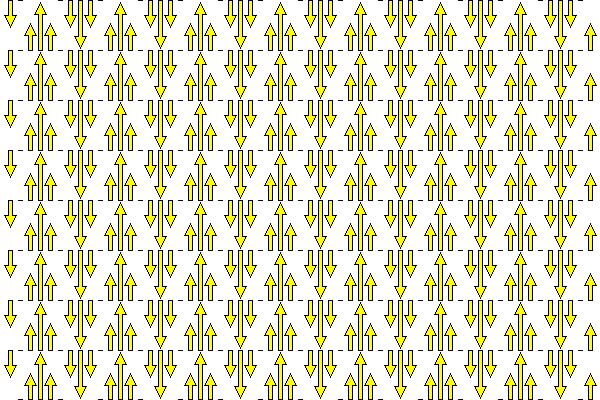
As a young man, Einstein began wondering what would happen if you traveled along with a beam of light. (Lots of people console themselves with the fact that Einstein did poorly in school. If you spend your spare time thinking about issues like this, then you can compare yourself to Einstein. Until then, hit the books.)
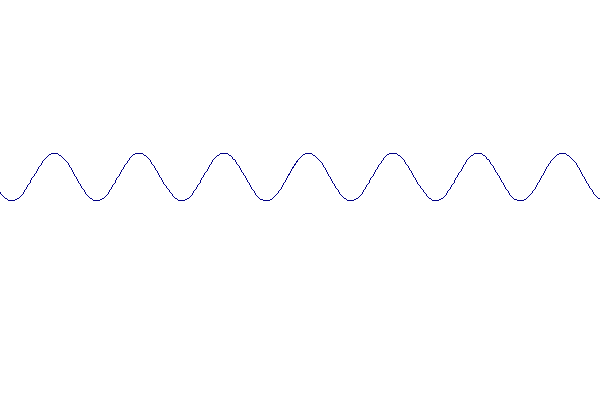
Obviously, you'd find yourself in a world with bands of alternating north and south magnetic fields, and positive and negative electric charge. Now a fundamental principle of physics is that the laws of physics don't change if you're moving at a constant velocity. Two stars may pass each other at hundreds of kilometers a second, but gravity works the same in either of their solar systems, and so on. So, if we can travel at the speed of light and observe these alternating magnetic and electric fields, we should see them at our own speed.
We don't.
There are two peculiar things about a world where light seems to be at rest. First, we see these bands of alternating magnetic and electric fields. Second, they don't seem to have a source.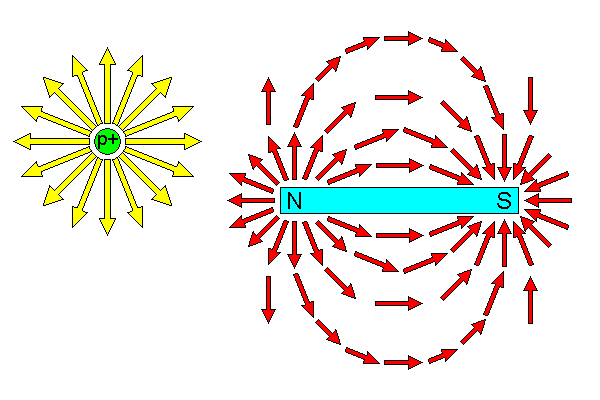
In our frame of reference, electric fields radiate away from electrical charges, and magnetic fields emanate from one pole of a magnet and converge at the other. We can make bands of alternating electrical of magnetic fields, but we'd have to create strips of alternating positive and negative electric charge or rows of magnets to do it. The magnetized stripes on the ocean floor that led to the concept of sea floor spreading are produced by strips of oceanic crust magnetized in different directions. But if you were riding along with a beam of light, you'd see alternating electric and magnetic fields, not connected to anything.
In our world, where light is moving, it's easy enough to see that once you started an oscillating electric field, say by making an electron vibrate, that changing electric field would create an oscillating magnetic field, which would create an oscillating electric field, and so on. I'll stop here before I start singing "The Circle of Life."
But in a universe where you could travel at the same speed as light, there would be no apparent source for these electric and magnetic fields. They would simply be "there."
Einstein eventually concluded there is no frame of reference where light is at rest.
Does The Speed of Light Vary With The Source?
If something is moving, it makes sense that if you throw something forward it will have a higher speed than if you threw it backward. If you're in a car traveling 100 km/hour, and you can throw a baseball 100 km/hour, then if you throw it forward its speed should be 200 km an hour relative to the ground, and if you throw it backward, its speed will be zero.
Let's suppose the speed of light varied with the source. For example, if something is coming toward you at 10 km/sec, its light is traveling toward you at c + 10 km/sec, and if something is traveling away the light will be traveling toward you at c - 10 km/sec.
An observer looking at the earth (orbital velocity 30 km/sec) from far away would see light traveling at c - 30 km/sec on one side of the earth's orbit and c + 30 on the other. The difference, 60 km/sec, is 2/10,000 the speed of light. In 10,000 seconds, the fast light will have gained on the slow light by 2 seconds. After a light year, the light has been traveling 31 million seconds and the fast light will have gained on the slow light by 6200 seconds or 1-3/4 hours. After 2500 light years, the faster light has gained on the slower light by 2500 x 2/10,000 = 0.5 years. In other words, when the "slow" light reaches an observer 2500 light years away, the "fast" light will get there at the same time. The observer will see two images of the earth on opposite sides of its orbit. There are many binary stars, and if the speed of light varied with the source, there should be cases where we see multiple images, stars disappearing and reappearing abruptly, and so on. We don't see any such thing.
And that's really not very shocking. Once you dip your oars into the lake to row a boat, the ripples spread outward at their own speed, not a speed related to your boat. Once a sound wave escapes from a siren, its speed is governed by the physics of sound, not the speed of the ambulance. Once a wave is emitted, it's no longer connected to the source, so it really isn't surprising that its speed has nothing to do with the source.
Does The Speed of Light Vary With The Receiver?
On the other hand, it seems like we have every right to expect the speed of a wave to vary with the receiver. For example, if a large landslide into a lake creates a wave traveling 30 km/hour, a boat traveling toward the wave at 25 km an hour will be hit at 55 km/hour, but a boat outrunning the wave at 25 km/hour will be hit by the wave at only 5 km/hr.
So when Albert Michelson and Edward Morley set up an experiment to measure tiny changes in the speed of light in 1887, they had every reason to expect to see variations. They did not see anything close to what was expected. It turns out the speed of light is independent of the observer.
Along Comes Einstein
Physicists Joseph Larmor, Hendrik Lorentz and Henri Poincare worked out the implications of Michelson and Morley's discovery. If the speed of light is constant for everybody, regardless of their motion, then the distance and time scales used to determine velocity must be elastic. Distance and time scales must change for different observers, but they change in such a way as to keep the speed of light constant.
What Einstein did was take this to the next level. He made two specific - very reasonable - assumptions about the laws of nature in different reference frames and showed that the changes in time and space were a consequence of those assumptions. His two assumptions were:
- The relationships between objects, forces, and laws of nature did not change with different inertial frames of reference. Energy and momentum are conserved, gravity and electromagnetism are inverse square law forces, and cause and effect is preserved. For example, if one billiard ball strikes another and transfers all its momentum and energy, it will do so for all observers. And no observer will ever see the second ball start moving before the first one strikes it, see a gap between the balls striking and the second ball start moving, or see one ball suddenly materialize in a completely different place. Since all the relative quantities are conserved, the theory came to be called relativity.
- Einstein's great insight from thinking about light: there is no frame of reference where light is at rest.
Inertial frames of reference are what mathematicians call a special case. That is, the motion is completely uniform, whereas motion in general can vary in velocity and direction. Since it deals with a special case, this aspect of relativity is called Special Relativity. Two important consequences of of Special Relativity are length contraction and time dilation.
Length Contraction
Einstein's predecessors had worked out the mathematics of length contraction, which is called Lorentz Contraction. However, they regarded it as an illusion caused by the finite speed of light. For example, if a spaceship travels by at half the speed of light, we will see the nose and tail by light emitted at different times
Einstein realized that the contraction is real. If it were an illusion, there would be some way to determine the true length of the spaceship. But there is no such measurement. Every possible measurement we could make to determine the length of the spaceship would show it shorter than it would be in our frame of reference.
Time Dilation
One natural observation that demonstrates time dilation is the observation of short lived subatomic particles called muons at the earth's surface. Muons are created by collisions between high energy particles and atoms in the upper atmosphere, 20 km and more above the surface. Muons have a lifetime of 2.2 microseconds. In a millionth of a second, light travels 300 meters, so muons should travel no more than 660 meters, on the average, before decaying. They should never make it to the surface, but they do, at the rate of about 10,000 per square meter per minute. The reason they survive so long is they are traveling close to the speed of light and time is slower in their frame of reference.
General Relativity
Much of special relativity already existed before Einstein
Gravity

If you were in a spaceship accelerating at one g, 9.8 meters per second per second, and you couldn't look outside, you'd have no way of knowing that you were moving. As far as you could tell, you might be in a closed room on Earth. Gravity and acceleration affect mass exactly the same way, to extremely high precision. Anything you can see in a closed room on Earth, you'd see in an accelerating spaceship. Objects would fall the same way, a tossed ball would follow the same path, and so on.
And this is where Einstein showed what it meant to be Einstein. He said, if acceleration and gravity are the same, then anything we see in an accelerating spaceship, we should also see as an effect of gravity. And it's not just about dropping things any more.
Gravitational Red Shift
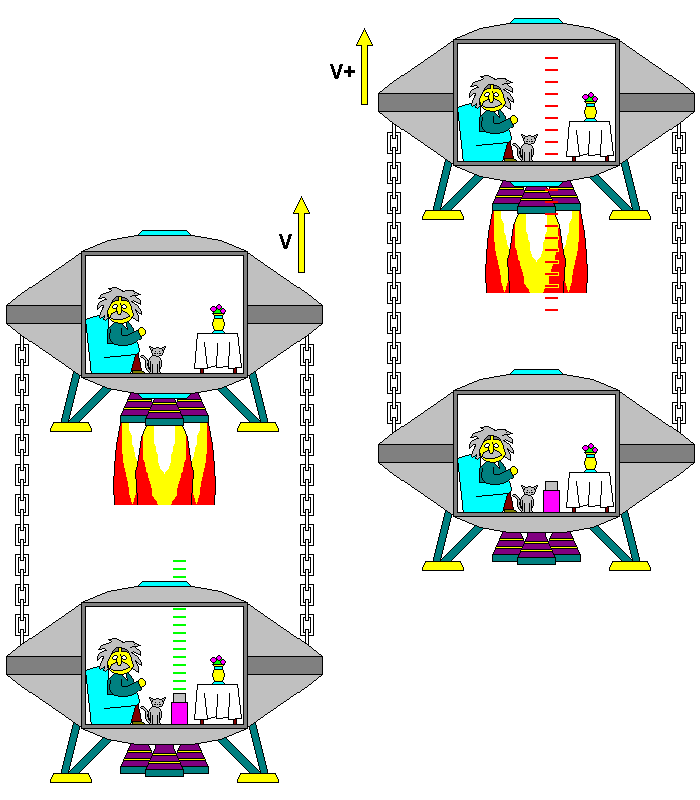
So let's imagine Einstein and his twin brother accelerating at one g in two spaceships connected by long chains (the ships are 1.5 light seconds apart). Feeling a need to communicate, rear Einstein sends a light pulse to forward Einstein.
By the time the light reaches forward Einstein, the spaceships are going faster (they're accelerating at just under 10 meters per second per second, so they've gained 15 meters per second). So forward Einstein sees the light overtaking him from behind, and it's red-shifted, because he's going faster compared to when the signal was sent.
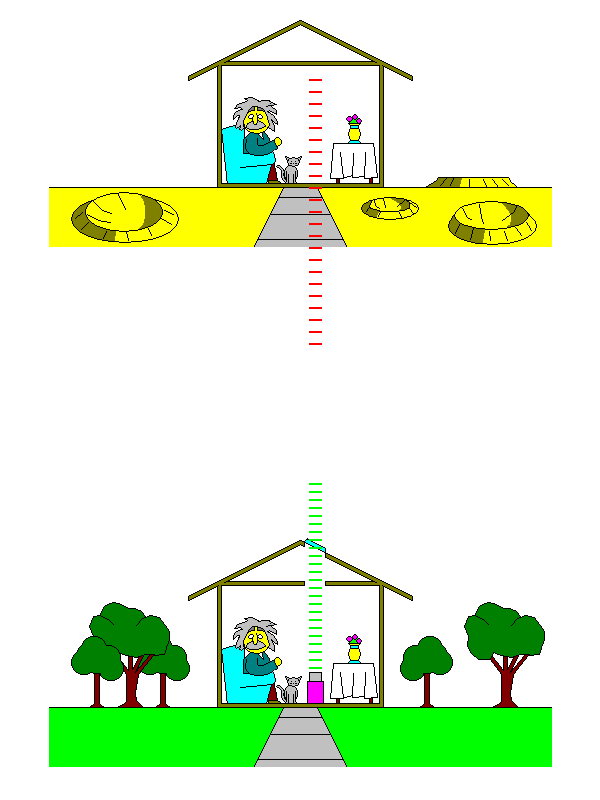
Now imagine Einstein is on Earth and his twin is on the Moon.
Why Is There A Doppler Effect?
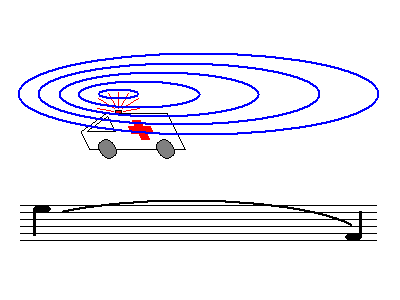
The analogy we use to illustrate the Doppler Effect is the familiar drop in pitch of an ambulance siren as the ambulance rushes by. The sound waves are compressed ahead of the ambulance and stretched out behind it.
300,000 km/sec Isn't Just a Good Idea - It's the Law
The principal reason you can't travel faster than light is that, in order to do so, you'd have to travel at the speed of light and see all the paradoxical things you'd see if light were at rest. But as if to enforce the speed limit, it would take an infinite amount of energy to get a material object moving that fast.
In normal motion, the energy of a moving object is 1/2 mv2, where m is the mass and v is the velocity. If m is kilograms and v is meters per second, then energy is in joules. So let's go for a modest interstellar expedition and launch a 1000 ton (million kg) spaceship to Alpha Centauri at 1/10 the speed of light, or 30,000,000 m/sec. The energy would be 1/2 (1,000,000)(30,000,000)2 = 4.5 x 1020 joules. U.S. energy consumption is about 1020 joules annually, so to get our spaceship to speed will take the energy use of the U.S. for 4.5 years. Double that to stop at Alpha Centauri, and double the total again to make the return trip home. A 1000 ton ship is pretty cramped for an 87-year round trip - it would be about the size of a submarine.
So even in classical mechanics, the logistics of going to the stars is pretty formidable. But it gets worse with relativity. In relativity, the energy of a moving object is E = γmc2, where γ = 1/ˆš(1-(v/c)2). As v approaches c, (v/c) approaches 1, and γ approaches infinity. It would take an infinite amount of energy to get a material object moving at the speed of light.
So how can light travel at the speed of light? Because it has no mass. In fact, anything with no mass must travel at the speed of light.
Light and Straight Lines
How do you draw a straight line? Use a ruler of course. How do you know the ruler is straight? Look along it. So in everyday experience, light defines straight. So how can light not travel in straight lines?
Well, there's another way to define straight. If you have two points on a plane, (x1, y1) and (x2, y2), the distance between them is d =ˆš((x2-x1)2 + (y2-y1)2). This is the familiar Pythagorean Theorem. If (x1, y1) = (0,0) and (x2, y2) = (3,4) then d = ˆš((3-0)2 + (4-0)2) = ˆš(9 + 16) = ˆš25 = 5. Also, if you have a point somewhere between the two points, the distance from the first point to the middle point, plus the distance from the middle point to the end point, equals the total distance from the start to the end point. The rules that describe how to measure distance in some particular system are called a "metric." The metric described here is called the Euclidean metric.
The Urban Metric
Is there any other kind of metric? Lots of them. In a large city, the straight line distance between two points is of interest only to pigeons. On the ground, a fire truck, ambulance or squad car can only travel along the streets. The rule for distance is d = |x2-x1| + |y2-y1|. The vertical bars mean "absolute value" - ignore the sign and take the quantity as positive. Unlike the Euclidean metric, in the urban metric there can be several possible lines that are the shortest distance between two points. Also, the number of possible alternative routes depends on the distance and direction. Along a diagonal there are many equivalent routes, but for two points on the same street, there is only one. Urban planners make use of the urban metric in planning things like locations of emergency services.
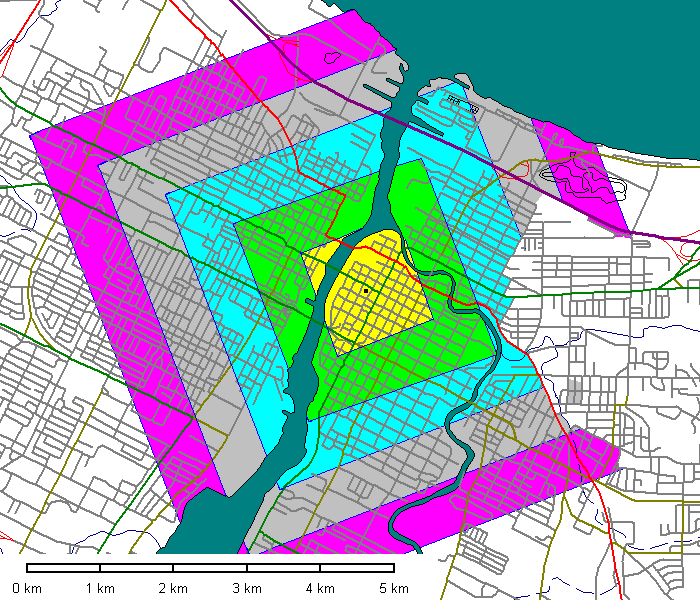
The map above shows distances from the courthouse in Green Bay, Wisconsin at 1-km intervals, as measured by street distances. That is, the boundary between the yellow and green areas is one kilometer from the courthouse. If you work in the courthouse and jog two kilometers during your lunch break, you could jog to any point on that boundary and back, sticking to streets and sidewalks. In the urban metric, "circles" - the points equidistant from the center - are diamonds.
It doesn't matter if the street pattern isn't perfect as long as there are some routes that get you to any desired distance. But if there's an area with a different street grid (east side of map) then this particular urban metric no longer works.
The Reno Metric
We use metrics all the time without thinking of it. In planning a drive to a town 100 miles away, we modify our estimates of driving time to take into account the roads, weather, construction, and terrain.
Let's say you have spent a weekend in Reno trying out a foolproof method for beating the system. Some very nice people have loaned you money to help you test out your theory. Unfortunately, it seems there were some overlooked factors in your system, and the nice people have informed you that Vinnie and Bruno from Accounts Receivable will be by shortly to collect their loan. You have no money and only enough gas to get 100 miles. How far from Reno can you get?
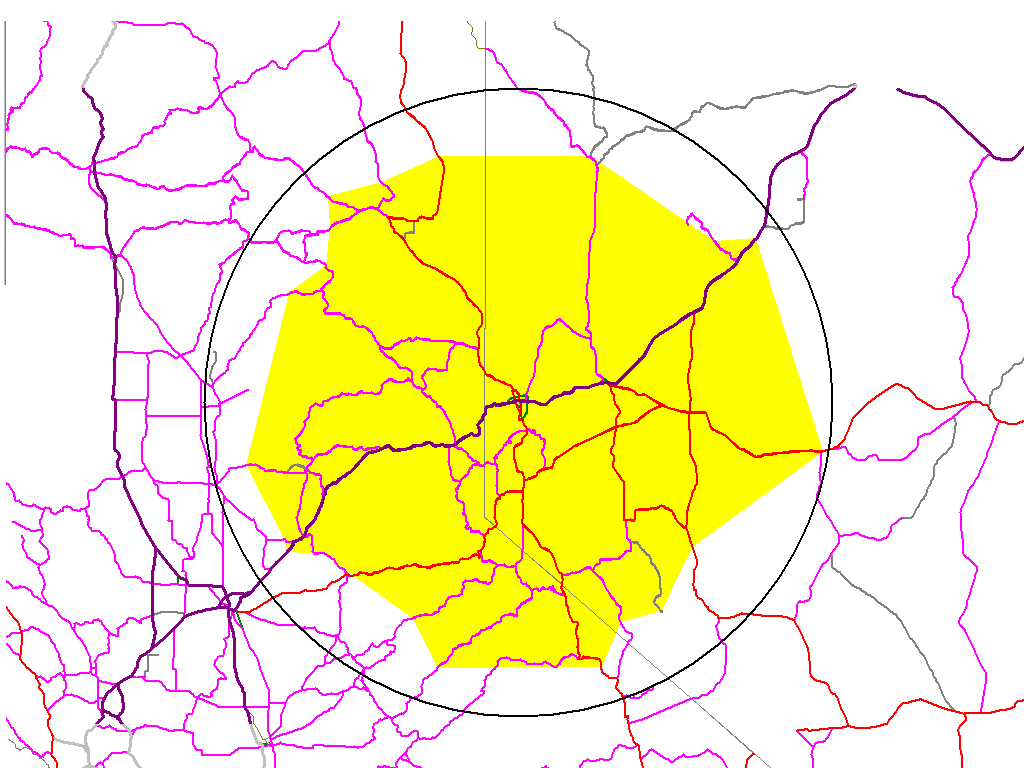
East of Reno, the roads wind between mountain ranges, and west of Reno the Sierra Nevada restrict travel, and 100 miles on the roads won't get you very far in a straight line. 100 miles on the Interstate will get you nearly100 miles in a straight line, and U.S. 50 (A.K.A The Loneliest Road In America) does even better, but for the most part the terrain limits travel severely.
The Green Bay Metric
You don't need anything as exotic as a black hole to warp space. A couple of large lakes will do nicely. Below is a map showing 500 mile driving distance from Green Bay.
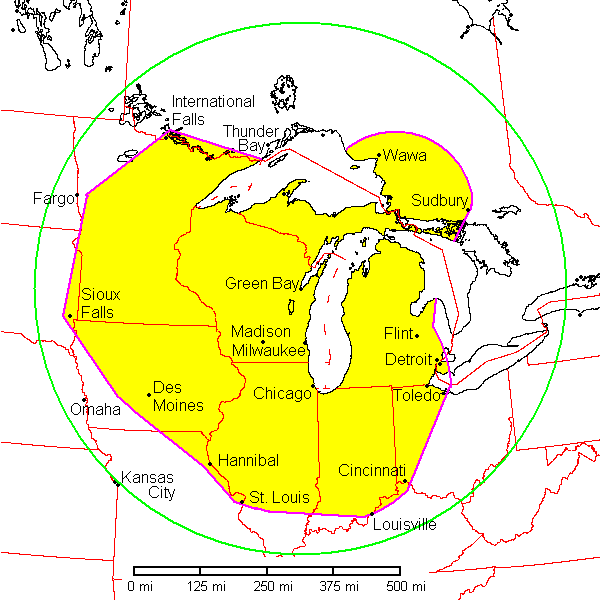
To the south of Chicago, there is a good radial system of Interstates and so the limit of 500 mile driving is roughly concentric with the straight line distance circle. To the northwest and southwest, the roads form a grid and the limit looks pretty much like the Urban Metric. But beyond the lakes, the geometry gets very distorted.
Worlds With Other Metrics
The urban metric, the Reno metric and the Green Bay metric are somewhat artificial in that, while we restrict ourselves to roads, birds and helicopters can fly in straight lines, so we can always say that those metrics act oddly because all lines in them are crooked.
But what if a "straight" line as defined by a ray of light doesn't obey the Euclidean metric measurement rules? Imagine a planet with a very dense atmosphere, say 20 times as dense as Earth's, so thick that atmospheric refraction equals the curvature of the planet. In principle, you could see the back of your own head by looking all the way around the world, except that with such a thick atmosphere, you wouldn't be able to see more than a few miles. [On Venus, with an atmosphere 90 times denser than Earth's, light is curved more than the curvature of the planet, and the horizon actually appears to be above the observer because of refraction.] The inhabitants of this world are intelligent, they have Euclidean geometry, which works just fine for building houses and bridges, and since a level laser beam a meter off the ground can hit a target a meter off the ground as far as the beam will go, they conclude that their world is flat. Since their view of the sky is murky at best, they never developed astronomy.
But as they start mapping further and further from home, their geometry gets weird. From their capital, at town O, they accurately survey a straight line to A, 400 kilometers east. They also survey a straight line from O to B, 300 kilometers north. So of course they expect a line from A to B to be exactly 500 kilometers long. It isn't. It's less. In double checking their work, they also make the disconcerting discovery that the angles in triangle OAB don't add up to 180 degrees, but a bit more.
They put their best minds to work on the problem. Meanwhile the surveyors keep on mapping. Unbeknownst to them, we are orbiting their planet and monitoring the surface with radar and infrared, so we know what's going on even if they don't (the Prime Directive keeps us from telling them). Eventually the survey parties make it from O, on the equator, to the north pole (but they don't have either concept since they think the world is flat). And they also make it 90 degrees eastward around the equator. As far as they know, their world is still flat. But when they analyze this survey, they get areal shock. From O to N, the north pole, is 10,000 kilometers. From O to P, 90 degrees east on the equator, is also 10,000 kilometers. And NP is 10,000 kilometers. ONP is an equilateral triangle. But all the angles between the survey lines are 90 degrees! They have an equilateral triangle with 90 degree angles and the sum of the angles is 270 degrees.
At this point the researchers working on the problem announce something amazing - there are other kinds of geometry than the geometry of a plane. What the surveyors have found is exactly what would happen on the surface of a sphere. Their apparently flat world is actually spherical. Not only that, but they can determine the size of the sphere and even predict that it should be possible to travel around it. Finally, it should be possible to locate four points on their world that are all equidistant from each other - something not possible on a flat world. (In spherical terms, they will be about 109 degrees apart. On Earth, the North Pole, Peru, northern Madagascar and the New Hebrides Islands in the Pacific are pretty close.)
In our world, mathematicians discovered other kinds of geometry, called non-Euclidean, by analyzing the basic assumptions of geometry and discovering that one of them wasn't essential. Euclid had stated that if you had a line and a point, there was only one line through the point parallel to the given line. It turns out other rules are possible. On a sphere, there are no parallel lines. If our hypothetical aliens ever try to construct a world record pair of parallel lines, they will discover that all lines on their world eventually intersect.
Return to Professor Dutch's Home Page
Created 08 July 2008, Last Update 17 January 2020